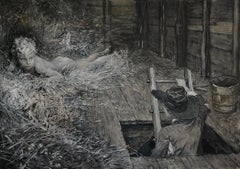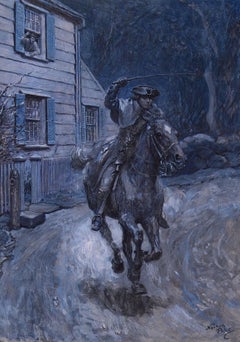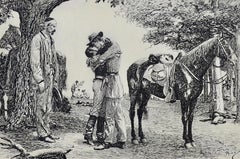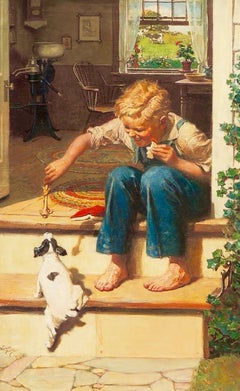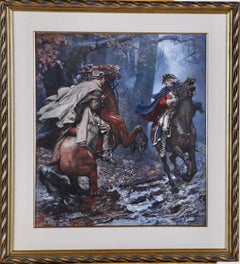Norman Price Art
to
6
3
2
2
Overall Width
to
Overall Height
to
13
1
1
6
8
5
13
10
9
5
4
3
2
1
1
1
1
1
1
9
5
5
4
4
13
8,227
2,805
1,654
1,312
12
13
Artist: Norman Price
Nude Boy Discovered in Barn - Gay Interest
By Norman Mills Price
Located in Miami, FL
Norman Mills Price depicts a handsome, nude blond boy with classical good looks. He is lying on his stomach in straw in the loft of a barn with his buttocks exposed. The artist captu...
Category
1910s Academic Norman Price Art
Materials
Gouache, Board, Pencil
Paul Revere Riding on Horseback
By Norman Mills Price
Located in Fort Washington, PA
Medium: Gouache on Illustration Board
Signature: Signed Lower Right
Magazine story illustration, Cosmopolitan, 1930;
Exhibited:
Fall 2004: Brandywine River...
Category
1930s Norman Price Art
Materials
Gouache, Illustration Board
Secret Service Operator 13, Magazine Story Illustration
By Norman Mills Price
Located in Fort Washington, PA
Story illustration for “End of the World,” the final installment of the serial “Secret Service Operator 13” by Robert William Chambers, published in Cosmopolitan, July 1933, illustra...
Category
1930s Norman Price Art
Materials
Ink, Paper
Boy Feeding Dog a Bone
By Norman Mills Price
Located in Fort Washington, PA
Medium: Oil on Canvas
Signature: Signed Lower Left
Norman Mills Price never fully received the popular recognition that his work deserved. Because he was so intently interested in h...
Category
1920s Other Art Style Norman Price Art
Materials
Canvas, Oil
"Love and the Lieutenant" Story Illustration, Woman's Home Companion
By Norman Mills Price
Located in Fort Washington, PA
Signed "Norman Price" Lower Right
"Gray! What are you doing here without your uniform?" Illustration for "Love and the Lieutenant" by Robert W. Chambers, published in Woman's Home C...
Category
1930s Norman Price Art
Materials
Watercolor, Gouache
Somewhere the Boys Are Drinking a Baker's Cocoa
By Norman Mills Price
Located in Fort Washington, PA
Young woman serving soldiers coffee/tea.
Signed lower left.
Norman Mills Price never fully received the popular recognition that his work deserved. Because he was so intently in...
Category
20th Century Other Art Style Norman Price Art
Materials
Watercolor
The Whistling Cat
By Norman Mills Price
Located in Fort Washington, PA
Story illustration for The Whistling Cat by Robert W. Chambers, Liberty magazine, November 21, 1931. Image of woman, young girl and dog at dory.
Signed...
Category
1930s Other Art Style Norman Price Art
Materials
Gouache, Paper
Violinist Admired by Women at Party
By Norman Mills Price
Located in Fort Washington, PA
Violinist Admired by Women at Party
Norman Mills Price never fully received the popular recognition that his work deserved. Because he was so intently interested in historical sub...
Category
20th Century Other Art Style Norman Price Art
Materials
Canvas, Oil
"I edged over and quietly drew her head over on my shoulder" story illustration
By Norman Mills Price
Located in Fort Washington, PA
Story illustration for “Whistling Cat” by Robert W. Chambers for Liberty magazine, published December 5, 1931, illustrated pages 42-43.
The image shows Juan, a Civil War soldier, an...
Category
1930s Norman Price Art
Materials
Paper, Ink
Pirates Destroying Ship
By Norman Mills Price
Located in Fort Washington, PA
Medium: Oil on Board
Signature: Signed Lower Right
Subject matter features pirates watching a ship burn from a distance a small rowboat with a figure returning to the ship after set...
Category
20th Century Norman Price Art
Materials
Oil, Board
Boy with Fish on Pole
By Norman Mills Price
Located in Fort Washington, PA
Medium: Ink on Paper
Signature: Signed Lower Right
Subject matter features a boy with a fish on a pole.
Category
20th Century Norman Price Art
Materials
Paper, Ink
Lief Erikson The Lucky, Book Illustration
By Norman Mills Price
Located in Fort Washington, PA
Approximate Date: 1939
Medium: Ink on Paper
Signature: Signed Lower Left
Dimensions: 7.50" x 12.50"
Leif Erikson The Lucky, Book Illustration, 1939
This...
Category
1930s Norman Price Art
Materials
Ink, Paper
Dora & John Bull
By Norman Mills Price
Located in Fort Washington, PA
Medium: Drawing
Dimensions: 6.63" x 8.00"
Signature: Signed Lower Center
Category
Early 20th Century Norman Price Art
Materials
Paint
Related Items
Silky Terrier Painting
Located in New York, NY
Original gouache, probably Belgian for matchbox covers. Mid-20th Century.
Category
Mid-20th Century Norman Price Art
Materials
Gouache, Board
After Heemskerck, Two Old Men siiting in an Inn, Drinking Scene, Old Master
By Egbert Van Heemskerck the Elder
Located in Greven, DE
After Heemskerck, Painting in the style of Heemskerck and Dutch Master, probably painted in the 19th Century.
Category
19th Century Baroque Norman Price Art
Materials
Canvas, Oil
$1,433 Sale Price
20% Off
H 14.26 in W 9.85 in
"Nude" Marguerite Stuber Pearson, Female Nude, Outdoor Boston School, American
By Marguerite Stuber Pearson
Located in New York, NY
Marguerite Stuber Pearson
Nude, circa 1940
Signed lower right
Oil on artist board
20 x 16 inches
Marguerite Stuber Pearson was an American painter best known for her elegant portra...
Category
1940s Academic Norman Price Art
Materials
Oil, Board
Pigging Out at the Diner, Surreal Anthropomorphic Pig Satirical Illustration
Located in Soquel, CA
A satirical, surreal depiction of a pig at a lunch counter by an unknown artist (20th Century). This scene, full of symbols and satire, portrays the anth...
Category
Late 20th Century Surrealist Norman Price Art
Materials
Oil, Illustration Board
$680 Sale Price
20% Off
H 28.5 in W 20 in D 2 in
The Apparition - Large, Fine 1884 French Oil Painting - MAKE OFFER
Located in New Orleans, LA
A stunningly dramatic and well-rendered oil on canvas painted by French artist Antoine Marie Roucole in 1884. With the ornate antique gilt plaster frame, and with its size, it has t...
Category
1880s Academic Norman Price Art
Materials
Oil
$7,500
H 41.5 in W 52.5 in
Simka Simkhovitch WPA W/C Painting Gouache American Modernist Beach Scene Nude
By Simka Simkhovitch
Located in Surfside, FL
Simka Simkhovitch (Russian/American 1893 - 1949)
This came with a small grouping from the artist's family, some were hand signed some were not.
These were studies for larger paintings.
This is a watercolor and gouache beach scene three young men bathing...
Category
1930s American Modern Norman Price Art
Materials
Gouache, Board, Watercolor
Lady with Books #3 - Surreal painting by Paula Craioveanu Framed
By Paula Craioveanu
Located in Forest Hills, NY
"Lady with Books 3"
39x23in / 100x60cm
Shipped as it is, stretched, framed. Size framed 41.5x25.7in
Free shipping with 1stDibs code
Lady with Books 3 and Lady with Books 1 - these ...
Category
2010s Academic Norman Price Art
Materials
Canvas, Acrylic
$4,000
H 39 in W 23 in D 1 in
PASSION #3 - nude male painting by Paula Craioveanu oil on canvas
By Paula Craioveanu
Located in Forest Hills, NY
"Passion #3" . Composition with Two Male Nudes, oil on canvas, 35.5x19.5in / 90x50cm
Part of "Wings of Gods" solo show, April 2024. see pictures from the show.
Shipped as it is, stre...
Category
2010s Academic Norman Price Art
Materials
Canvas, Oil
$1,800 Sale Price
40% Off
H 35.5 in W 19.5 in D 1 in
Classical Naturalistic Style Italian Allegory Study
Located in Houston, TX
Classical style allegorical painting with puti and monarchy type figures floating within the clouds. The canvas is framed in a decorative gold frame.
Dimensions Without Frame: H 43.5...
Category
20th Century Academic Norman Price Art
Materials
Oil
Seashore Town- Mid-Century Modernist Gouache and Oil Painting
Located in Marco Island, FL
A dramatic painting of a seaside town done in bright colors. The abstract American scene style captures the moody sky, and the reflection of water captures the viewer's attention.
...
Category
Mid-20th Century Norman Price Art
Materials
Oil, Gouache, Board
$7,000
H 21 in W 25 in D 2 in
Simka Simkhovitch WPA Artist Painting Gouache American Modernist Beach Scene
By Simka Simkhovitch
Located in Surfside, FL
Simka Simkhovitch (Russian/American 1893 - 1949)
This came with a small grouping from the artist's family, some were hand signed some were not.
These were studies for larger paintings.
Simka Simkhovitch (Симха Файбусович Симхович) (aka Simka Faibusovich Simkhovich) (Novozybkov, Russia May 21, 1885 O.S./June 2, 1885 N.S.—Greenwich, Connecticut February 25, 1949) was a Ukrainian-Russian Jewish artist and immigrant to the United States. He painted theater scenery in his early career and then had several showings in galleries in New York City. Winning Works Progress Administration (WPA) commissions in the 1930s, he completed murals for the post offices in Jackson, Mississippi and Beaufort, North Carolina. His works are in the permanent collections of the Dallas Museum of Art, the National Museum of American Art and the Whitney Museum of American Art. Born outside Kyiv (Petrograd Ukraine) into a Jewish family who owned a small department store. During a severe case of measles when he was seven, Simcha Simchovitch sketched the views outside his window and decided to become an artist, over his father's objections. Beginning in 1905, he studied at the Grekov Odessa Art School and upon completion of his studies in 1911 received a recommendation to be admitted to the Imperial Academy of Arts. Though he enrolled to begin classes in architecture, painting, and sculpture at the Imperial Academy, he was dropped from the school roster in December because of the quota on the number of Jewish students and drafted into the army. Simchovitch served as a private in the 175th Infantry Regiment Baturyn [ru] until his demobilization in 1912. Re-enrolling in the Imperial Academy, he audited classes.
Simka Simkhovitch exhibited paintings and sculptures in 1918 as part of an exhibition of Jewish artists and in 1919 placed 1st in the competition "The Great Russian Revolution" with a painting called "Russian Revolution" which was hung in the State Museum of Revolution. In 1922, Simkha Simkhovitch exhibited at the International Book Fair in Florence (Italian: Fiera Internazionale del Libro di Firenze). In 1924, Simkhovitch came to the United States to make illustrations for Soviet textbooks and decided to immigrate instead. Initially he supported himself by doing commercial art and a few portrait commissions. In 1927, he was hired to paint a screen for a scene in the play "The Command to Love" by Fritz Gottwald and Rudolph Lothar which was playing at the Longacre Theatre on Broadway. Art dealers began clamoring for the screen and Simkhovitch began a career as a screen painter for the theater. Catching the attention of the screenwriter, Ernest Pascal, he worked as an illustrator for Pascal, who then introduced him to gallery owner, Marie Sterner. Simkhovitch's works appeared at the Marie Sterner Gallery beginning with a 1927 exhibit and were repeated the following year. Simkhovitch had an exhibit in 1929 at Sterner's on circus paintings. In 1931, he held a showing of works at the Helen Hackett Gallery, in New York City and later that same year he was one of the featured artists of a special exhibit in San Francisco at the California Palace of the Legion of Honor in Lincoln Park. The exhibit was coordinated by Marie Sterner and included four watercolors, including one titled "Nudes". He is of the generation of Russian Soviet artists such as Isaac Pailes, Serge Charchoune, Marc Chagall, Chana Orloff, Isaac Ilyich Levitan, and Ossip Zadkine.
In 1936, Simkhovitch was selected to complete the mural for the WPA Post office project in Jackson, Mississippi. The mural was hung in the post office and courthouse in 1938 depicted a plantation theme. Painted on the wall behind the judge’s bench, “Pursuits of Life in Mississippi”, a depiction of black workers engaged in manual labor amid scenes of white professionals and socialites, was eventually covered over in later years during renovations due to its stereotypical African American imagery. Simka painted what he thought was typical of Jackson. His impression of pre-civil rights Mississippi was evidently Greek Revival column houses, weeping willow trees, working class families, and the oppression of African Americans. He painted African American men picking cotton, while a white man took account of the harvest and a white judge advised a white family, calling it Pursuits of Life in Mississippi.
Though clearly endorsed by the government and initially generally well-received, the mural soon raised concerns with locals as the climate toward racial segregation began to change. The main concern was whether depictions that show African Americans in subjugated societal roles should be featured in a courtroom. The following year, his painting "Holiday" won praise at an exhibition in Lincoln, Nebraska. In 1940, Simkhovitch's second WPA post office project was completed when four murals, "The Cape Lookout Lighthouse and the Orville W. Mail Boat", "The Wreck of the Crissie Wright", "Sand Ponies" and "Canada Geese" were installed in Beaufort, North Carolina. The works were commissioned in 1938 and did not generate the controversy that the Jackson mural had. The main mural is "The Wreck of the Crissie Wright" and depicts a shipwreck which had occurred in Beaufort in 1866. "The Cape Lookout Lighthouse and the Orville W. Mail Boat" depicted the lighthouse built in 1859 and the mail boat that was running mail during the time which Simkhovitch was there. The boat ran mail for the area until 1957. "Sand Ponies" shows the wild horses common to the North Carolina barrier islands and "Canada Geese" showed the importance of hunting and fishing in the area. All four murals were restored in the 1990s by Elisabeth Speight, daughter of two other WPA muralists, Francis Speight...
Category
1930s American Modern Norman Price Art
Materials
Gouache, Board
18th century oil sketches for a Baroque interior - a pair
Located in London, GB
A FEAST OF THE GODS WITH VENUS AND BACCHUS
Collections:
With Appleby Brothers, London, June 1957;
Hazlitt, Gooden & Fox, London, 1961;
John and Eileen Harris, acquired from the above, to 2015.
Literature:
Jacob Simon and Ellis Hillman, English Baroque Sketches: The Painted Interior in the Age of Thornhill, 1974, cat. no.12 (as by Louis Laguerre);
Elizabeth Einberg (ed.), Manners and Morals: Hogarth and British Painting, 1700-1760, exh. cat., London (Tate Gallery), 1987, cat. no.10 (as by Louis Laguerre);
Tabitha Barber and Tim Bachelor, British Baroque: Power and Illusion, exh. cat., London (Tate Britain), 2020.
Exhibited:
Twickenham, Marble Hill House, English Baroque Sketches: The Painted Interior in the Age of Thornhill, 1974, no.12 (as by Louis Laguerre);
London, Tate Gallery, Manners and Morals: Hogarth and British Painting, 1700-1760, 1987, no.10 (as by Louis Laguerre);
London, Tate Britain, British Baroque: Power and Illusion, cat. no 92, 2020.
CUPID AND PSYCHE BEFORE JUPITER
Collections:
With Appleby Brothers, London, June 1957;
Hazlitt, Gooden & Fox, London, 1961;
Anthony Hobson, acquired from the above, to 2015.
These recently re-united paintings are the most ambitious surviving baroque ceiling sketches made in Britain in the early eighteenth century. From the Restoration until the rise of Palladianism in the 1720s decorative history painting formed the preeminent artistic discipline in Britain. It was a field dominated by Continental artists including the Italian Antonio Verrio and the Frenchmen Louis Laguerre and Louis Chéron...
Category
Early 18th Century Baroque Norman Price Art
Materials
Canvas, Oil
$244,773
H 36 in W 48.13 in
Previously Available Items
The Battle of the Wilderness
By Norman Mills Price
Located in Fort Washington, PA
Medium: Gouache on Board
Dimensions: 27.00" x 12.75"
Signature: Unsigned
Written by Price on the mount below the image: Like endless lines of phantoms, men, horses, guns, wagons, continued to pass through the smoking forest.
A striking and emotional night scene at the Battle of the Wilderness...
Category
Early 20th Century Norman Price Art
Materials
Gouache, Board
Norman Price art for sale on 1stDibs.
Find a wide variety of authentic Norman Price art available for sale on 1stDibs. If you’re browsing the collection of art to introduce a pop of color in a neutral corner of your living room or bedroom, you can find work that includes elements of purple and other colors. You can also browse by medium to find art by Norman Price in paint, watercolor, gouache and more. Not every interior allows for large Norman Price art, so small editions measuring 5 inches across are available. Customers who are interested in this artist might also find the work of Olaf Schneider, Daniel Hughes, and Elizabeth Lennie. Norman Price art prices can differ depending upon medium, time period and other attributes. On 1stDibs, the price for these items starts at $1,500 and tops out at $35,000, while the average work can sell for $9,700.
